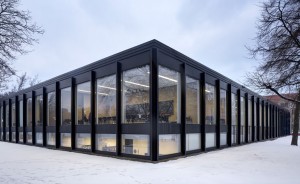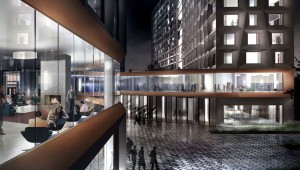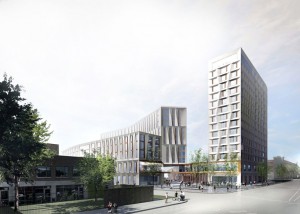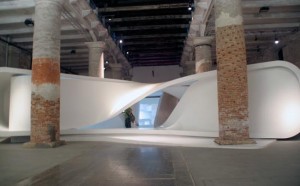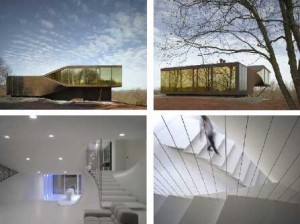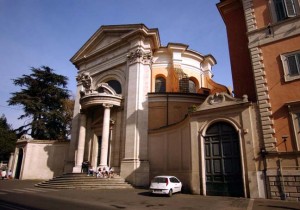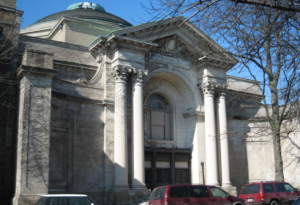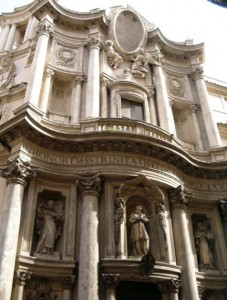It is exceedingly rare to find any firsts in Deleuze. Or seconds, or thirds for that matter. Some concepts have ‘priority’ in thought, such as the articulable before the visible, but the relationship is otherwise dialectical. Deleuze cites Peirce’s theory of firstness, secondness and thirdness, but even Peirce admits that each folds into the other levels. It came as a surprise, then, to read Deleuze’s categorical assertion, “Art begins not with flesh but with the house. That is why architecture is the first of the arts” (WIP 186). Architecture is both a beginning and a first–that’s a first. Deleuze’s concepts typically evade any teleological or causal capture: concepts, images, affects and percepts are diffusely distributed along undulating and laminated planes of immanence, composition and reference; sections cut across these planes, revealing bursts or snap-shots of momentary interpenetration amongst images/concepts/affects traversing space-time. Such a dynamic cosmos is paradigmatically a-centric. The rhizome has no beginning nor end, just perpetual middleness. The closest Deleuze otherwise comes to an origin is in chaos, the outside, which always intrudes not in the beginning of something, but in the interstice outside and between frames. Deleuze would not agree, “in the beginning there was only chaos,” he would contend that “in the middle there is only chaos,” and it is the spirit of Art to ‘take a bit’ of that chaos and inscribe it, freeze it, into a “frame of order to form a composed chaos that becomes sensory” (WIP 206). Philosophy and Science also biopsy chaos, capture it in their own epistemological glass slide and, through the frames of their respective planes of thought, conjecture a chaosmos out of ordering concepts, affects and functions.
Why does architecture enjoy such primacy in Art for Deleuze? Deleuze explains that because “it endlessly produces and joins up planes and sections” (186) architecture is defined by ‘frames’: windows, doors, ground, roof, and walls, all of which have provided frames for the installation, application or hanging of art. Frames within frames. Yet, Deleuze also values cinema for its frames, its movement of frames and the relations it catalyzes amongst its many rapidly sequenced frames. Architecture frames inside the frames of the cinematic image too, as in the films of Ozu or Wong Kar Wai. For that matter, however, as mentioned in a preceding quote, all art frames samplings of chaos, as does Philosophy and Science. Perceptions, affections and sensations are themselves, frames, too. What explains Deleuze’s frame of mind? How can architecture assume primacy in this art of framing? And, if it indeed does, why is it that Deleuze seldom considers the “out-of-frame” of the picture frame, the movie frame, or the window frame that is always constituted by larger volumes of architectural framing and the relationships this fosters between the art-frame and the cosmos beyond and between? Architecture provides nested and laminated framings: not like the proximate borders of a triptych, but the choir, cathedral, gallery or showroom delineating a diagram with it and all the other human and nonhuman actors its contours enframe. I argue Deleuze’s frame of mindset fixates on the relational, and that, for Deleuze, what is important is less that frames circumscribe paintings, surfaces, video projections, perceptions and desktops, than that such misleading discreteness negatively frames a universal space of betweenness and interstice, opening up figures and contents to the admission of immanent relationality, and thus the changing of the whole.
Deleuze’s analysis of the out-of-field provides an indirect analytical framework for contemplating the work of frames in architecture. Deleuze argues that cinema proves that “the frame ensures a deterritorialisation of the image” (MI 15). Any phenomenon that can be captured within a cinematic frame, be it a cascading tear-drop rippling across gigantically magnified pores or the largest entity on earth, the pacific ocean, as seen through a lens on an Apollo spacecraft, will share a common datum of measurement that will invite relations that otherwise do not share a “denominator of distance, relief or light” (MI 15): the screen. Such images are deterritorialized from their original contexts and scale, and reterritorialized into the framing of the screen and the montaged sequence of shots. Just as Deleuze and Guattari, in A Thousand Plateuas, explain how a wasp and an orchid deterritorialize and reterritorialize each other as the wasp extracts sustenance from the orchid and the orchid replicates through the wasp’s deposits, forming a rhizome or a body without organs, so do the cinematic images and the montaged film deterritorialize in the frame of the screen and then reterritorialiaze in the screen-frame that pollinates the movie palace and its spectators. Deleuze tells us “doors, windows, box office windows, skylights, car windows, mirrors, are all frames in frames” (MI 14) and it is by “this dovetailing of frames that the parts of the set…are separated, but also converge and are reunited.” Framing determines an out-of-field, and this out-of-field determines yet a larger frame, or a larger set. And thus, Deleuze identifies two types of the out-of-field: one is that which exists outside the frame between proximal or emanating frames, and the other is the virtual relation to a whole that is always open.
Returning to the possible architecture that exists before and around the screen, let us consider the first out-of-field scenario. How does the out-of-field of the screen deteritorrialize the film in the frame and visa versa? Consider the same film in two architectural frames: the 2006 film Snakes on a Plane projected in the Pantages Movie Palace in Hollywood and the same film projected in-flight on a plane. Both Snakes-on-a-Plane hybrid space would become differently: the first would likely add legitimacy to an otherwise inscrutably awful film, provoking an affective flow across the human observers and the rococo-revival, gilt ornamental proscenium framing the screen, while no airline would agree to show the film in transit. When Fight Club was aired on Virgin Atlantic, the airline included a separate inset disclaimer at every seat warning passengers that the film contained “a brief but graphic plane crash.” Just as a sugar cube dissolving into a glass of ice tea illustrates, for Deleuze, the nature of a whole, that is constantly changing throughout the relational dynamics of its constituent parts, we can imagine two very different bodies-without-organs emerging from the flow of affects across frames within a screen and the screen within the framing architecture and constituent human and nonhuman agents in this example. The rhizome of these two architectural framings of the frames-within-frames would flow through the imaginary of an entire Snakes-on-a-Plane public, immanently contingent upon the other framing architectures and constituents agents (themselves frames) that comprise the Snakes-on-a-Plane-Plane. As Paul Klee observed, in Art “the people are always missing” because they will always emerge out-of-field, outside the art-frame and immanently depend upon the context of the architecture and other bodies that will deteritorrialize and reterritorialize the art figures.
In What is Philosophy?, Deleuze describes flesh, the house and the cosmos as frames within frames, passing from the finite to the infinite. Flesh is a framing organ through which sensation passes and becomes. Sensation is the process of becoming of a plant or animal as it becomes-other, as a force or movement passes across bodies, transferring a rhythm through the ‘vibration’ of sensation. Flesh only reads this becoming, or acts as its “thermometer” (179), but never actually constitutes sensation, which is always a flowing bloc of affects and percepts made ‘visible’ through the flesh. The forces of sensation moving across bodies, making a human-nonhuman becoming of the subject in an environment, and visa versa, is captured in Bacon’s blurred and spasmodic figures. In these distorted swirls or ‘fused’ and “broken tones” (179), the pigments of the depicted figure flow and blend into those of the contour, the house and the field. Herein lies painting’s “eternal object” (180), the rendering visible of invisible forces, like sensation. But, as Deleuze sees in Bacon’s paintings, these sensational forces are expressed in the smeared streaks of flesh as becomings of figure, field and contour, or in other words, flesh, house and cosmos in a “zone of indiscernibility, that is common to several forms, irreducible to any of them” (LOS 50). The figure and the contour are not transforming into each other but deforming into each other as they become by ‘escaping’ their respective forms, just as the image of a wasp-territory is deterritorialized into the wasp-orchid rhizome, or how the cinematic image is deterritorialiazed in the screen-frame. In short, the architecture of the frame — as contour, as house, as screen, as picture frame — mediates between the figure, flesh or image within it and the cosmos, or chaosmos, beyond it but, despite its appearance, does not delineate an intransigent boundary. Sensation — blocs of affects and percepts — act as forces that flow among cosmos, house and flesh as man’s ‘nonhuman becomings,’ where the “ambiguous house” architecture “exchanges and adjusts them, makes them whirl around like winds” ( WIP 183). To return to a previous example by way of illustration, the framing of Snakes-on-a-Plane on-a-plane, both deforms the images within it to the framing headrest before you, which as they pass beyond to the subsequent frame of the plane’s interior, the clouds streaking through yet other framing windows at 700mph, begins to deform all the bodies together into a body without organs whose anatomy consists of cinematic plane images, and plane images, cinematic images of snakes in overhead compartments, and overhead compartments with virtual contents, the screaming face of Samuel L Jackson and the raised pores and flushed pigments of the passenger gripping an armrest as the force of sensation courses through the rhizome.
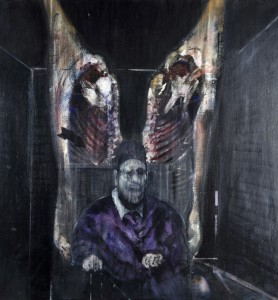
To conclude with a final illustration of architecture as the frame around dovetailing frames, let’s briefly consider the curation of Bacon’s Figure with Meat in gallery 389. Following Deleuze’s analysis, we can see how the seated figure and the flanking flanks of beef that are its attendants have a triptych-like relation of form, hue and geometry together. The figure is seated between the attendant meat and is framed by the white outline of a room’s edges, whose surfaces disappear into a field of black. The hues of the flesh and fat in the attending meat, the hues of the black field, the white of the architecture’s outline all converge, fuse and confuse into a zone of indeterminacy at the exact center of the painting, where the figures head dissolves into the meat and the shadowy field between the two slabs. If we zoom out of the painting, we find ourselves in gallery 389, a third floor corridor at the modern wing of the Art Institute. There are no shadows here. Renzo Piano’s “cloud,” the large brise soleil filtering northern light into the gallery from above neutralizes all shadow. But the whites of the rooms contours, of the meat’s ribs, of the figure’s dissolving, screaming face transmit a rhythm beyond the picture-frame. Further down the hallway, immediately to the left of the painting, a wall of glazing frames another figure: Frank Gehry’s Pritzker
Pavilion. Seen at night, the bending, layered, fragmented petals of stainless steel comprising the bandshell are illuminated with reds and purples. The stage walls within the frame of the bandshell are wood, however, and illuminated with an intense magenta, which make the entire composition appear like a giant screaming mouth, the red tongue belting the evening’s music as the face explodes into the bandshell’s confetti-like form. The resemblance could be called uncanny, but Deleuze does not dally in the uncanny. This is a body without organs, where each component is a framed organ and yet not “organised” into discrete entities because the frames fold into each other and harmonize with figure and flesh, color and cosmos. In this “haptic vision,” seen through the framing spectacles of architecture, the “armature, Figure, and contour” of the Bacon painting as well as of the AIC and Pritzker Pavilion “communicate and converge in color” (LOS 122).


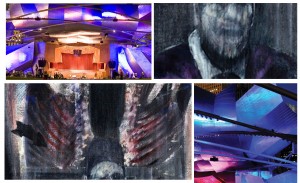
 Humpty Dumpty sat on a wall,
Humpty Dumpty sat on a wall,